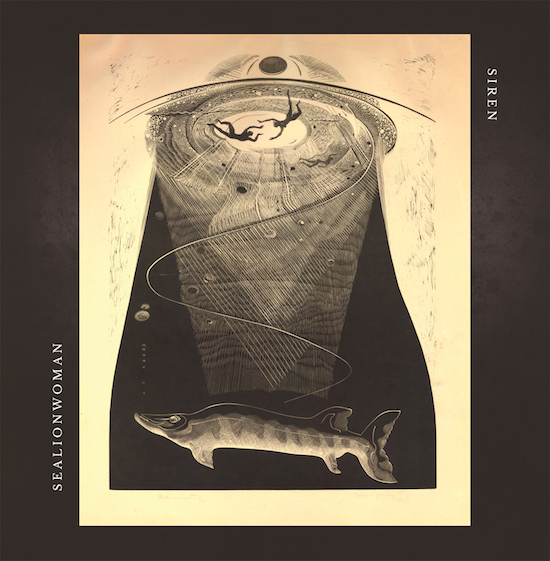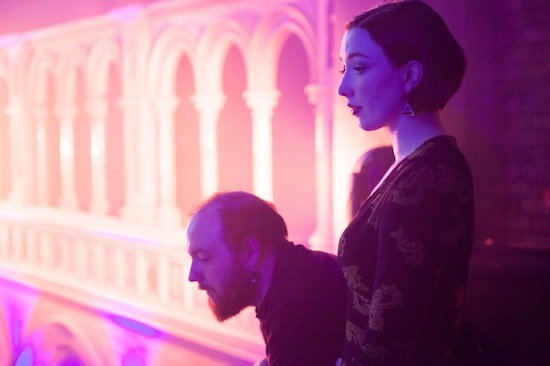Sealionwoman’s music flips folk music on its head, taking traditional Scottish music and moving it into a darker, more atmospheric direction. Soundtracked by the experimental double bass playing of Tye McGivern and narrated by the vocals of Kitty Whitelaw, their debut LP Siren is a record quite unlike any you will hear this year.
The first track from the record, ‘Call’ is one element of a wide-ranging record. The track brings reminders of the early work of Norwegian folk experimentalist Hanne Hukkelberg, Scott Walker’s The Drift, and Stockhausen, with electronic loops swirling around the dirge-like double bass. It transports you to a dark otherworld, with Whitelaw’s vocals adding to the bleak atmosphere.
Having been a band for eight years before their debut, Siren was developed from Selkie – a live theatrical performance the duo put on at London’s Vaults festival. In Scottish folklore, the Selkie – a mythological therianthropic creature that was part-seal, part-human – is coerced into a relationship with a man who steals her skin so that she can’t return to water. The Sealionwoman version involved the Selkie cursing the man so that he couldn’t return to land. The bleakness of the tale lends itself to the dark atmosphere created on Siren.
‘Call’ captures this turning point from the traditional tale, with Whitelaw’s Selkie singing “I curse you thus, to stay upon the sea / For you have stolen what once belonged to me”, as she calmly waits for the man’s mind to break.
“I will stay at home and I will tend the croft and I will sit and watch the waves
And i will sit and comb my hair that softly, softly, softly lingers there and i will wait.”
The sound on Siren is incredibly dense – it’s scarcely believable that Sealionwoman is just a duo. Talk us through the construction of ‘Call’ – how does the atmosphere get created?
Tye McGivern: Almost all of what happens on ‘Call’ is happening live between the two of us, there’s a looped drone that underpins it, and some points where I capture Kitty’s vocal, but really it’s just one bass being fed through three amplifiers.
Kitty Whitelaw: I have to give credit to Tye for creating such amazing soundscapes. Even though we’ve been making music for years, even now I still get hairs on my neck standing up when we’re on stage because of the sounds he manages to create. He’s incredibly inventive with his technical set up.
TM: It’s inventive in so much as my playing is fairly non-traditional and that it’s uncommon for a double bass to be manipulated and distorted to the extent that we do. It’s also unusual for vocals to be pulled in live and made part of the texture of the track.
Where does that inventiveness and experimentation come from?
KW: Ever since the first band practice we’ve tried to mix things up because we both get bored easily. Everything that we have set up now has happened through experimentation, equipment breaking, being replaced by something completely different or sometimes not being replaced at all. In the past we’ve played shows where we’ve had some of Tye’s electronics be incredibly temperamental and that’s forced us to spontaneously change our sound for a song or for an entire set. But this kind of live experimentation is basically what created our sound that we have now.
TM: It’s happened quite a few times that some part of the electronics has spontaneously given up the ghost during a set. Sometimes that’s meant just tearing out a lead an going straight to an amp, which loses delays and samples but keeps a tone that can be controlled by playing. Sometimes, as in Edinburgh last year, the amp I was borrowing that had been no trouble in sound check developed so big of a hum that we had to abandon it after the first song an effectively play acoustically.
It’s nerve wracking for us when it happens, but generally I think it has made us consider how much we need to rely on those aspects of the sound to play and it means that we’ll try out versions of tunes with and without any manipulation, so we know there’s somewhere to go if it all fails.
Siren stemmed from Selkie, which was a stage show that was a grander theatrical performance compared to the usual band on a stage show. What goes into your live sets?
TM: I think we like to consider all aspects of our gigs in a theatrical way, even if just in simple ways like convincing a tech not to have all the rock & roll flashing lights on constantly so that we can build an atmosphere in the space and work with that.
KW: Since I was a little girl I’ve considered music and live performance to be something that goes hand-in-hand. When I started attending shows as a gothy youth I felt like I wanted more than the triple band bill. That’s why I was attracted to metal so much, I loved going to the shows because of how theatrical they were.
You talk of your distaste for the ‘triple band bill’ and your love of the theatrical. How does that tie in with the practicalities of being an independent band? Is it about doing more shows like Selkie or do you have to be part of the traditional gig culture?
KW: Oh I don’t hate the triple band bill! As a young band we had to deal with a lot of classic triple band bill shows in tiny back rooms where the other bands didn’t remotely share any musical connection. It left me feeling really frustrated and angry. Since then we’ve supported some phenomenal live acts such as Bohren And Der Club Of Gore, Tanya Tagaq, Ex- Easter Island Head, and Emanantive.
TM: We’re still part of traditional gig culture certainly, but I think we are fortunate enough to not do much by way of lazily put together triple line up shows. Being slightly harder to genre-define lets us sit into different types of shows an makes us a likely to be playing next to a pair of gospel-blues fiddlers as a doomjazz group.

It must be exciting playing with such a range of interesting artists?
KW: I love being on a bill with other bands because you can learn so much from watching other people play. Their music has really shaped who we are now.
And similarly, your influences – folk, jazz, metal, Morphine, Yeah Yeah Yeahs. How does Sealionwoman square all of these?
KW: All bands that you listen to in your life sort of create this aural patchwork that eventually creeps into your own music. I was originally attracted to the Yeah Yeah Yeahs because of Karen O’s theatricality and the simple set up of voice, bass and drums. It’s like the perfect stripped back jazz trio. I wanted to be the melodic instrument with a rhythm section.
I guess folk has sneaked in there after years of being forced to listen to traditional Scottish music while my Dad drove miles across the hills of Scotland on our summer holidays. I had a real hatred of folk and traditional music in my childhood and teens. I felt compelled to reject my musical heritage, and then suddenly years later I was in Cecil Sharp House learning Scottish folk ballads. I’ve never felt more Scottish than when I was living abroad in Singapore and Paris, so when I returned it was time to face whatever I was running away from. The main metal influence is undeniably Deftones. When we were a trio we used to do dirgey doom jazz covers of Deftones for our live sets.
TM: It’s low music with minimal line-up that sits on a drone and tells a story, uses effects, distortion and dissonance, while leaving space for improvisation and interaction between the players.
KW: If there is one person that weaves everything together in my musical inspiration patchwork and that would have to be Bjork. She has stayed with me from the first time I listened and subsequently cried while listening to Vespertine buried under my covers in my bed – to me stretching and dancing around to ‘The Gate’. Her genre fluidity opened up a lot of doors to me and encouraged me to take more musical leaps of faith. Also I think her music has shown me how important fragility can be. I think that shows in Siren. The record is an incredibly personal record about love and loss. It should feel raw and heartfelt.
Siren is out 12 October via Antigen Records


